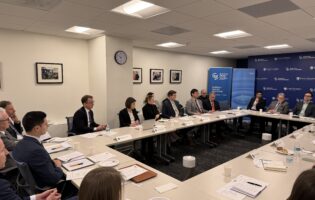Cities and States as Global Actors
AGI held its second annual “Transatlantic Dialogue of the States, Cities, and Communities” on Tuesday, June 9, 2015. The conference examined how states and cities address the challenges of the twenty-first century and how they interact and learn from each other.
Panel I: How Cities are Responding to the Energy Transformation
Cities play a vital role in addressing climate change and energy transformation. Climate change represents a new major threat to cities and the absence of global conventions on climate makes actions taken on a local level even more crucial in the long run. Transformational factors are impacting cities at the local level, and despite the growing interconnection and globalization of cities, place matters more than ever. Cities compete for infrastructure and technology but they also learn from each other.
Several German cities are leading the way in energy transition. The city of Bottrop is an example of an innovative redevelopment project that has received international attention. In 2010, Bottrop won a grant o become “InnovationCity Ruhr” so as to counteract far-reaching structural changes affecting the city and its region. Bottrop has been a mining town for the past 150 years and is home to the last coal pit to be closed in Germany, after mining subsidies run out in 2018. The closure of the coal mine will result in the loss of many jobs and apprenticeship places.
Studies show that around 1,000 new jobs need to be created in the region to compensate for those lost in the mining sector. One of the targets set with the project “InnovationCity” is to reduce 50 percent of CO2 emissions in a distinct city district by 2020. But aside from being a green urban development project, the goal is also to give the city a vision for its future after the mining industry. Therefore, it is also an economic project that aims to attract new businesses and create new jobs in the “Green Economy.” Other cities in Germany such as Stuttgart have developed a set of similar priorities with a strong focus on sustainable mobility, climate protection, and decentralization and regionalization of energy production and distribution.
On an international level, the transatlantic dialogue between cities has been a great success, as exemplified by the strong links developed between Northern Virginia and the Stuttgart region regarding approaches to issues including regional land use, transportation, and environmental planning. The partnership between the Northern Virginia Regional Commission (NVRC) and the Verband Region Stuttgart (VRS) officially began in 1999 when the NVRC and the VRS entered into the first-ever international cooperative agreement between two regional government agencies.
One area in which Northern Virginia can greatly learn from its partner overseas is solar energy. Germany is the world leader in solar installations; Northern Virginia is currently changing its policy framework to pass new legislation requiring Dominion Power to install 400MW of solar by 2020. A Virginia Solar Energy Development Authority has also been created and 2014 already saw a thirty-three percent increase in Solar PV capacity in Northern Virginia. But with a total solar capacity of 3.3 MW, the region still has a long way to go before reaching the level attained in the Stuttgart region (with 90,430 Solar PV installed and a solar capacity of 1,569 MW).
Questions during the Q&A dealt with the blue-red gap on climate change in the U.S. The fact that military assets are endangered because of climate change and that there is a real return on investment for taxpayers are arguments that have convinced Republicans in Virginia to implement new policies targeted toward climate change issues.
Panel II: Immigration Reform and Cities of Migration
This panel focused on several sensitive issues, including how immigrants are incorporated into society and how national and subnational bureaucracies deal with these trends, and each speaker highlighted the struggles faced by authorities on the local level. Local authorities have to deal with this issue “face-to-face,” working directly with immigrants on a daily basis. American and German approaches to these situations are dissimilar and belie cultural differences and mindsets toward migrants in general. Still, common themes unite both countries in this dialogue—namely, how immigrants can access city services and how integration benefits both sides of the equation in the long-run. Immigrants can often be caught in a vicious cycle, as they deal with poor language skills, which feed in to poor employment outcomes and low educational attainment.
However, places on both sides of the Atlantic are working to combat these problems. For example, the German state of Hessen, which has a population of around six million—25 percent of whom are of an immigrant background—is dealing with an influx of young migrants, which they must incorporate into society. The state recently published an integration report that catalogued the vicious cycle mentioned above, and authorities have since incorporated policies like required German language classes from a very young age, special preschool classes, and integrated sports clubs to quickly and successfully deal with these issues. Other locales like Detroit and Berlin are also dealing with these problems effectively, as they strive to improve the quality of life of these inhabitants and that of the average citizen.
Speakers highlighted how both nations need immigrants as an economic stimulus and for cultural enrichment. Both nations are built on a legacy of migration, and both have struggled with this thorny issue. As immigration increases and as the ethnic and cultural makeup of societies change, immigrants will become even more important in the future. Federal authorities, often somewhat removed from the reality on the city or local level, should take note of the efforts that cities are putting in place to help incorporate and integrate immigrants into society. Cities are taking notice of the efforts of other cities, solving their own problems by occasionally outstripping and exceeding the measures put in place on the national level. Federal authorities are much less able to engage individuals, and it remains the responsibility of cities to perform the vital task of welcoming immigrants and including them in society. The speakers present highlighted the need and desire to accomplish these difficult tasks successfully.
Panel III: TTIP and Its Impact on Cities and States
The third panel discussion focused on the opportunity that the currently negotiated Transatlantic Trade and Investment Partnership (TTIP) represents for SMEs in the U.S. and Europe. Speakers stressed that SMEs are the backbone of the American and European economies. The U.S.’ thirty million SMEs account for nearly two-thirds of net new private sector jobs in recent decades but many of them are not currently exporting because of tariffs and complicated regulatory hurdles. TTIP will enhance U.S.-EU SME cooperation and help SMEs on both sides of the Atlantic seize investment opportunities by facilitating exports. For instance, one goal of TTIP is to eliminate double certification for companies and to establish more simple and transparent procedures for rules of origin. Since investment follows trade, but states in general, particularly California, Texas, New York, and Florida, as well as SMEs would see substantial benefits from a free trade agreement with the EU. For states such as Mississippi, where Latin American trade far exceeds European trade, TTIP would create significant new opportunities for firms specialized in chemicals, forest products, minerals, and fuels, which are Mississippi’s top industrial goods exported to the EU but face high tariffs.
Some U.S. states already see the benefits of trade and investment from Europe. One example mentioned during the panel discussion was the BMW plant in South Carolina, which is the biggest factory for the German automaker. This plant played a huge role in creating jobs and attracting new companies and foreign investment to the region surrounding Spartanburg County. Germany, which is already highly internationalized and export-oriented, would also largely benefit from TTIP. In a World Bank study ranking economies on their ease of doing business, the U.S. ranked only seventh, after countries such as Norway and South Korea. At the moment, U.S. tariffs and approval procedures can make it very difficult for EU companies to export.
Summary written by Gray Barrett and Alix Auzepy
[flickr set=”72157653953160348″]
Location
Carnegie Endowment for International Peace (CEIP)
1779 Massachusetts Ave, NW Choate Room Washington, DC 20036 United States







